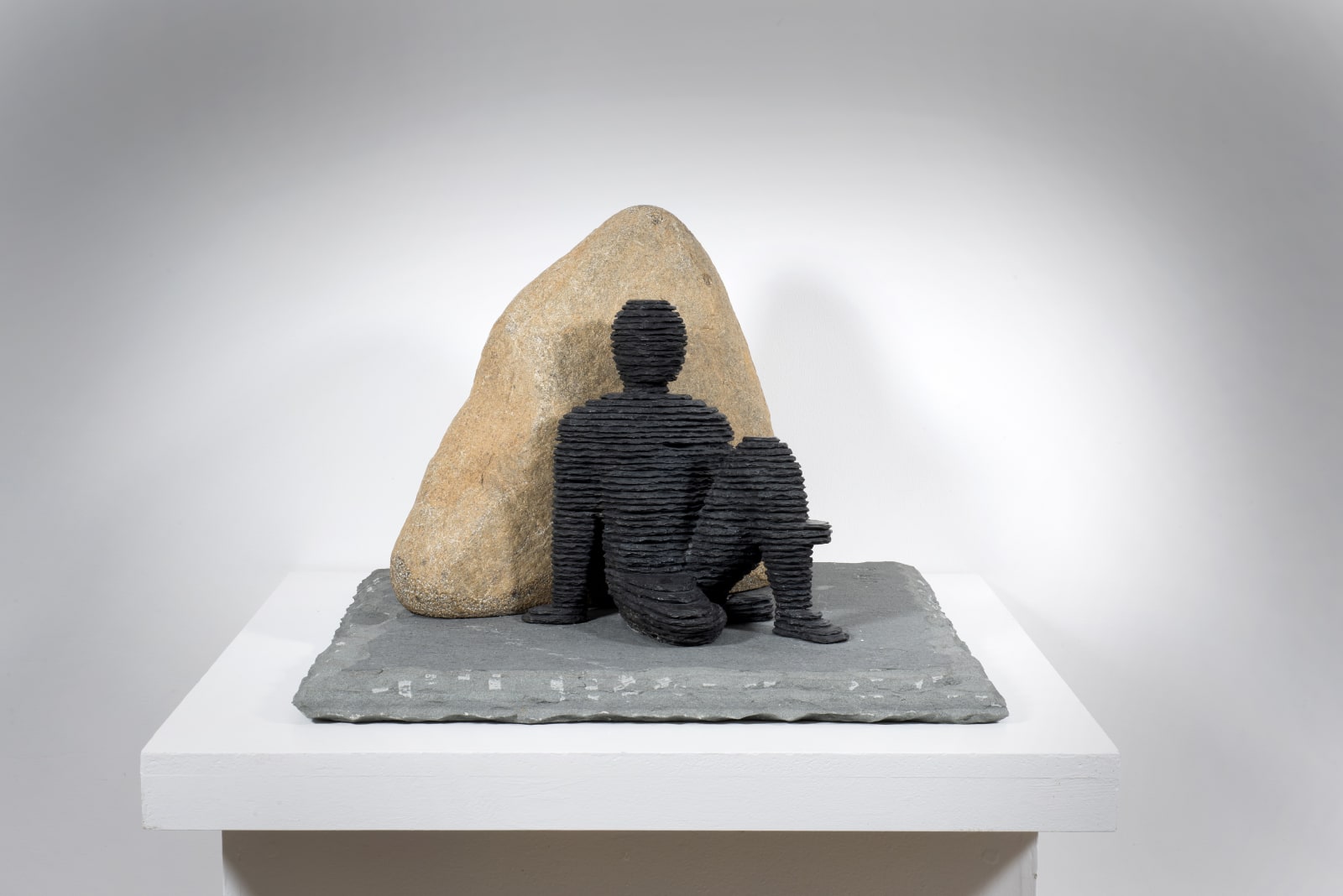Boaz Vaadia
Ge'u'el, 2002
Bronze, bluestone and boulder
16 x 23 x 23 in, 40.6 x 58.4 x 58.4 cm
Initaled 'B.V' and numbered '6/7'
There are few artists who can be said to have created a new visual language, and even fewer who have recognised the primitive power of man’s first creations and managed...
There are few artists who can be said to have created a new visual language, and even fewer who have recognised the primitive power of man’s first creations and managed to turn them into poetry.
Throughout his career, spanning 50 years, the American-Israeli sculptor Boaz Vaadia shaped an art form indebted to the spirit of the natural world. This essential respect for the land, rocks, sticks and stones beneath our feet was understood by Vaadia from an early age as he watched his father plough the fields of the family’s farm in Israel to produce a bounty of strawberries and peanuts. From these humble beginnings, Vaadia learnt to harness the energy of mother earth and cherish natural materials as holy relics or treasured antiquities.
Born in Israel in 1951, Vaadia travelled to New York in the early 1970s with a scholarship to study at the Brooklyn Museum Art School and Pratt Institute. Bringing his early primitive structures crafted in human hair, leather and sheep hides to the USA, Vaadia discovered the same spirit of the ancient rocks from his home in rural Israel in this new urban landscape. Vaadia surrendered to the materials that now surrounded his studios in SoHo and Williamsburg, sourcing abandoned slate and ancient boulders torn up from the city’s sidewalks to guide him as his work gradually turned towards the figure in the 1980s. For Vaadia, this intimate connection to the natural world, stemming from his childhood, informed the profound spirituality of his artwork.
As part of a generation of sculptors with Anthony Gormley and Jaume Plensa, Vaadia explored a featureless and so universal human form that traced the very development of mankind. From his early conceptual pieces to stoic figures in bluestone and slate, Vaadia’s oeuvre is defined by a timeless human presence akin to the primeval Egyptian sphinxes, Greek Kouroi or African fetishes. His majestic bodies, arranged in groups or sometimes standing alone, were each created from layers of fragile material shaped by careful movements of the artist’s hammer and chisel. With each flicker of his hand, Vaadia formed the harmonious relationship between figure, stone and the essential forces of life and gravity in nature. Gradually this process turned to bronze; carefully maintaining the feeling of each stone while recognising the history of this traditional medium.
Vaadia has been the subject of major exhibitions around the world, including his most recent celebrated retrospectives at the Open Museum in Tefen this year and at the Grounds for Sculpture Museum, New York in 2016. His work can now be found in prominent public places internationally including the Time Warner Building, New York; Museum of Modern Art, San Francisco; Metropolitan Museum of Art, New York; Tokyo Metropolitan Teien Museum, Tokyo; Hakone Open-Air Museum, Hakone; Ravina Sculpture Park, Chicago and Israel Museum, Jerusalem as well as private collections
Throughout his career, spanning 50 years, the American-Israeli sculptor Boaz Vaadia shaped an art form indebted to the spirit of the natural world. This essential respect for the land, rocks, sticks and stones beneath our feet was understood by Vaadia from an early age as he watched his father plough the fields of the family’s farm in Israel to produce a bounty of strawberries and peanuts. From these humble beginnings, Vaadia learnt to harness the energy of mother earth and cherish natural materials as holy relics or treasured antiquities.
Born in Israel in 1951, Vaadia travelled to New York in the early 1970s with a scholarship to study at the Brooklyn Museum Art School and Pratt Institute. Bringing his early primitive structures crafted in human hair, leather and sheep hides to the USA, Vaadia discovered the same spirit of the ancient rocks from his home in rural Israel in this new urban landscape. Vaadia surrendered to the materials that now surrounded his studios in SoHo and Williamsburg, sourcing abandoned slate and ancient boulders torn up from the city’s sidewalks to guide him as his work gradually turned towards the figure in the 1980s. For Vaadia, this intimate connection to the natural world, stemming from his childhood, informed the profound spirituality of his artwork.
As part of a generation of sculptors with Anthony Gormley and Jaume Plensa, Vaadia explored a featureless and so universal human form that traced the very development of mankind. From his early conceptual pieces to stoic figures in bluestone and slate, Vaadia’s oeuvre is defined by a timeless human presence akin to the primeval Egyptian sphinxes, Greek Kouroi or African fetishes. His majestic bodies, arranged in groups or sometimes standing alone, were each created from layers of fragile material shaped by careful movements of the artist’s hammer and chisel. With each flicker of his hand, Vaadia formed the harmonious relationship between figure, stone and the essential forces of life and gravity in nature. Gradually this process turned to bronze; carefully maintaining the feeling of each stone while recognising the history of this traditional medium.
Vaadia has been the subject of major exhibitions around the world, including his most recent celebrated retrospectives at the Open Museum in Tefen this year and at the Grounds for Sculpture Museum, New York in 2016. His work can now be found in prominent public places internationally including the Time Warner Building, New York; Museum of Modern Art, San Francisco; Metropolitan Museum of Art, New York; Tokyo Metropolitan Teien Museum, Tokyo; Hakone Open-Air Museum, Hakone; Ravina Sculpture Park, Chicago and Israel Museum, Jerusalem as well as private collections
